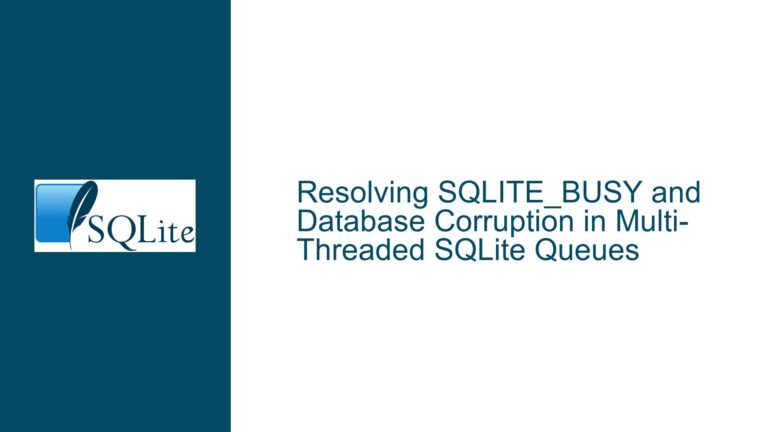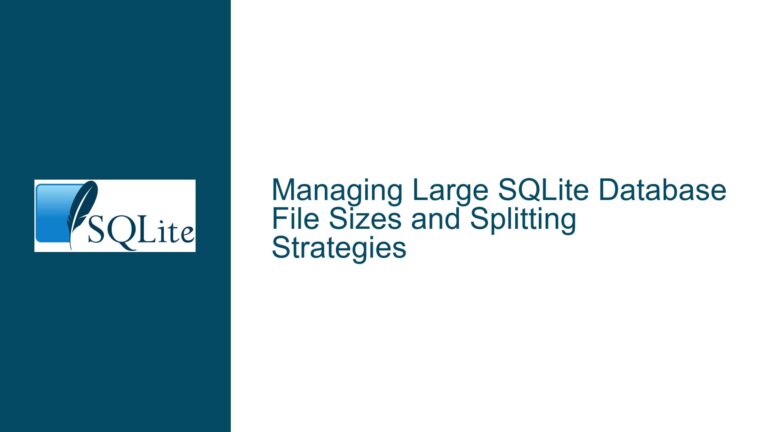Deploying Millions of SQLite Databases on AWS: Challenges and Solutions
SQLite Database Deployment Strategy for One Million Users on AWS
Deploying one million SQLite databases on AWS, with one database per user, presents a unique set of challenges that require a carefully considered architecture. The primary goal is to ensure data integrity, minimize costs, and maintain efficient access to each user’s database. The proposed strategy involves storing each SQLite database as a separate file in Amazon S3, dynamically pulling the database to a local machine when a user makes a request, and syncing changes back to S3 after a period of inactivity. While this approach captures the essence of the problem, it introduces several critical issues that need to be addressed, including data loss risks, S3 API costs, consistency concerns, and snapshotting challenges.
The core of the problem lies in balancing the trade-offs between performance, cost, and reliability. Storing each database as a separate file in S3 provides scalability and isolation but introduces latency and potential data consistency issues. Dynamically pulling databases to local machines can reduce latency for active users but risks data loss if a machine fails before syncing changes back to S3. Additionally, the cost of S3 API operations, such as PUT and GET requests, can quickly escalate with millions of users and frequent updates. These challenges necessitate a deeper exploration of the architecture and potential solutions.
Risks of Data Loss and Inconsistent State in Distributed SQLite Deployment
One of the most significant risks in the proposed architecture is the potential for data loss or inconsistent state. When a user’s database is pulled to a local machine, any changes made to the database are temporarily stored on that machine. If the machine fails before the changes are synced back to S3, those changes will be lost. This scenario is particularly problematic in distributed systems, where machine failures are not uncommon. Even if the failure rate is low, the sheer scale of one million users means that data loss could affect a significant number of users over time.
Another concern is the consistency of the database state across multiple machines. If two users attempt to access the same database simultaneously, and the database is pulled to two different machines, changes made on one machine may not be reflected on the other. This inconsistency can lead to data corruption or conflicting updates. While S3 now provides strong consistency for object storage, this does not eliminate the risk of edge cases, such as multi-part uploads or downloads, where different parts of a file may be updated or retrieved at different times.
The lack of a system-wide snapshot further complicates the issue. In a distributed environment, it is challenging to capture a consistent snapshot of all user databases at a specific point in time. This limitation makes it difficult to perform backups, audits, or migrations without introducing additional complexity. The absence of a snapshot mechanism also means that recovering from a catastrophic failure, such as a region-wide outage, would be nearly impossible without significant data loss.
Optimizing S3 API Costs and Naming Strategies for SQLite Databases
The cost of using S3 API operations is another critical consideration when deploying millions of SQLite databases. Each PUT and GET request incurs a cost, and with one million users generating multiple updates per day, these costs can quickly add up. For example, if each user generates ten updates per day, the system would require ten million PUT requests daily, resulting in significant expenses. Additionally, other API operations, such as LIST and DELETE, further contribute to the overall cost.
To mitigate these costs, it is essential to optimize the frequency and volume of S3 API operations. One approach is to batch updates, where multiple changes are grouped into a single PUT request. However, this strategy introduces additional complexity, as it requires tracking changes and ensuring that batched updates do not conflict with concurrent operations. Another approach is to reduce the frequency of syncing changes back to S3, but this increases the risk of data loss in the event of a machine failure.
The naming strategy for SQLite database files in S3 also plays a crucial role in ensuring consistency and avoiding conflicts. A poorly designed naming scheme can lead to race conditions, where two processes attempt to create or update the same file simultaneously. For example, if a file does not exist in S3 when a process checks for it, but another process creates the file before the first process attempts to upload it, the result could be data corruption or overwritten changes. To avoid this, the naming strategy should incorporate unique identifiers, such as user IDs or timestamps, to ensure that each file is distinct and conflicts are minimized.
Implementing EFS and Alternative Solutions for Scalable SQLite Deployment
Amazon Elastic File System (EFS) presents a potential alternative to S3 for storing and accessing SQLite databases. EFS provides a scalable, shared file system that can be mounted on multiple EC2 instances, allowing multiple machines to access the same set of files simultaneously. This approach eliminates the need to pull databases to local machines, as all instances can directly access the databases stored on EFS. However, EFS introduces its own set of challenges, including latency and cost considerations.
EFS is designed for low-latency access, but the performance may not be sufficient for high-throughput applications with millions of users. Additionally, EFS costs are based on the amount of data stored and the number of read/write operations, which can become expensive at scale. Despite these challenges, EFS offers several advantages, such as simplified data management and the ability to maintain a consistent state across multiple instances. For applications where data consistency and ease of management are prioritized over cost and latency, EFS may be a viable solution.
Another alternative is to use a distributed database system that natively supports horizontal scaling, such as Amazon Aurora or CockroachDB. These systems are designed to handle large-scale deployments and provide built-in mechanisms for data replication, consistency, and fault tolerance. While migrating from SQLite to a distributed database system would require significant effort, the long-term benefits in terms of scalability and reliability may outweigh the initial investment.
Best Practices for Deploying Millions of SQLite Databases on AWS
To address the challenges of deploying millions of SQLite databases on AWS, several best practices can be implemented. First, it is essential to design a robust data synchronization mechanism that minimizes the risk of data loss and ensures consistency across multiple machines. This can be achieved by implementing a write-ahead log (WAL) or journaling mechanism that tracks changes and ensures that they are reliably synced back to S3. Additionally, using a distributed lock manager can prevent concurrent access to the same database, reducing the risk of conflicts and data corruption.
Second, optimizing S3 API usage is critical to controlling costs. This can be achieved by batching updates, reducing the frequency of sync operations, and using lifecycle policies to transition infrequently accessed data to lower-cost storage classes. Implementing a caching layer, such as Amazon ElastiCache, can also reduce the number of S3 API requests by serving frequently accessed data from memory.
Third, adopting a consistent and conflict-free naming strategy for SQLite database files is essential to avoid race conditions and ensure data integrity. Using unique identifiers, such as user IDs or timestamps, in file names can help prevent conflicts and simplify data management.
Finally, exploring alternative storage solutions, such as EFS or distributed database systems, can provide additional options for scaling and managing large deployments. While each solution has its own trade-offs, carefully evaluating the specific requirements of the application can help identify the most suitable approach.
In conclusion, deploying millions of SQLite databases on AWS requires a comprehensive understanding of the challenges and trade-offs involved. By addressing the risks of data loss, optimizing S3 API usage, and exploring alternative solutions, it is possible to design a scalable and reliable architecture that meets the needs of the application.






